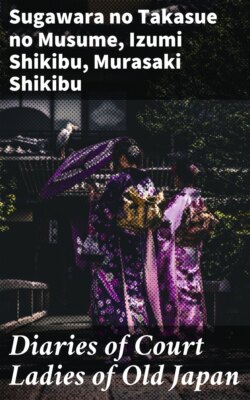Читать книгу Diaries of Court Ladies of Old Japan - Murasaki Shikibu - Страница 4
На сайте Литреса книга снята с продажи.
TRANSLATORS' NOTE
ОглавлениеThe poems in the text, slight and occasional as they are, depending often for their charm on plays upon words of two meanings, or on the suggestions conveyed to the Japanese mind by a single word, have presented problems of great difficulty to the translators, not perfectly overcome.
Izumi Shikibu's Diary is written with extreme delicacy of treatment. English words and thought seem too downright a medium into which to render these evanescent, half-expressed sentences and poems—vague as the misty mountain scenery of her country, with no pronouns at all, and without verb inflections. The shy reserve of the lady's written record has induced the use of the third person as the best means of suggesting it.
Of the "Sarashina Diary" there exist a few manuscript copies, and three or four publications of the text. Some of them are confused and unreadably incoherent. The present translation was done by comparing all the texts accessible, and is especially founded on the connected text by Mr. Sakine, professor of the Girls' Higher Normal School, Tokio, published by Meiji Shoin, Itchome Nishiki-cho, Kanda-ku, Tokio. As far as possible the exact meaning has been adhered to, and the words chosen to express it have been kept absolutely simple, without complexity of thought, for such is the vocabulary in which it was written. Sometimes the diarist uses the present tense, sometimes the text seems reminiscent. The words in square brackets have been inserted by the translators to complete the sense in English of sentences which literally rendered do not carry with them the suggestion of the Japanese text.
CONTENTS
INTRODUCTION BY AMY LOWELL
| I. | THE SARASHINA DIARY | |
| II. | THE DIARY OF MURASAKI SHIKIBU | |
| III. | THE DIARY OF IZUMI SHIKIBU |
APPENDIX
ILLUSTRATIONS
COURT LADY'S FULL DRESS IN THE HEIAN PERIOD Colored Frontispiece
From Kokushi Daijiten, by kind permission of Mr. H. Yoshikawa. The figure was drawn for the purpose of showing the details of dress and therefore gives no indication of the grace and elegance of the costume as worn. It shows the red karaginu, or over-garment; the dark-green robe trimmed with folds, called the uchigi; the saishi, or head-ornament, in this case of gold but sometimes of silver; the unlined under-garment of thin silk; the red hakama, or divided skirt; and the train of white silk painted or stained in colors.
"IT WAS ALL IN FLOWER AND YET NO TIDINGS FROM HER" KICHŌ: FRONT AND BACK VIEWS A NOBLEMAN'S HOUSE AND GROUNDS IN THE AZUMAYA STYLE: PLAN OF BUILDINGS AND GARDEN THREE KICHŌ PUT TOGETHER OLD PRINT OF A NOBLEMAN'S DWELLING IN THE AZUMAYA STYLE From an old book. COURT DRESS OF MILITARY OFFICIAL (in color)
From Kokushi Daijiten, by kind permission of Mr. H. Yoshikawa. The figure shows the zui, or ornament of the head-strap holding the head-dress in place; also the method of rolling up the gauze flap of the head-dress. Tucked into the red state coat appear a half-spread fan and some folded sheets of paper, and at the back is seen a quiver made of lacquered wood. Underneath the red coat the hakama is shown. The shoes are of Chinese pattern.
ROYAL DAIS AND KICHŌ, SUDARÉ, ETC. From old prints. A NOBLEMAN'S CARRIAGE SCREENED DAIS PREPARED FOR ROYALTY From a print in an old book. "HIS HIGHNESS CAME IN A HUMBLE PALANQUIN" "THE LADY GOT UP AND SAW THE MISTY SKY" "STRANGELY WET ARE THE SLEEVES OF THE ARM-PILLOW" "IN THE DAYTIME COURTIERS CAME TO SEE HIM"
